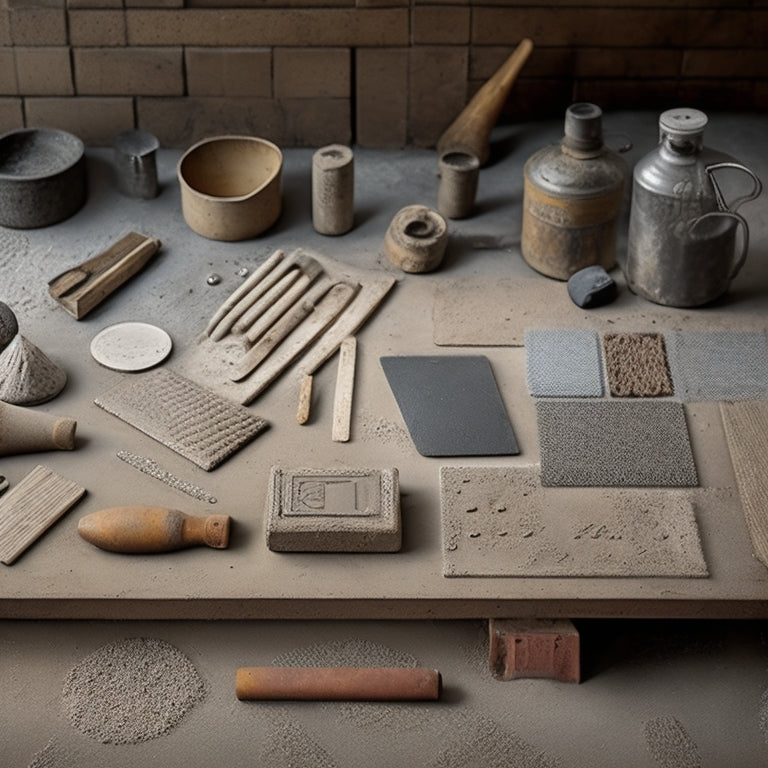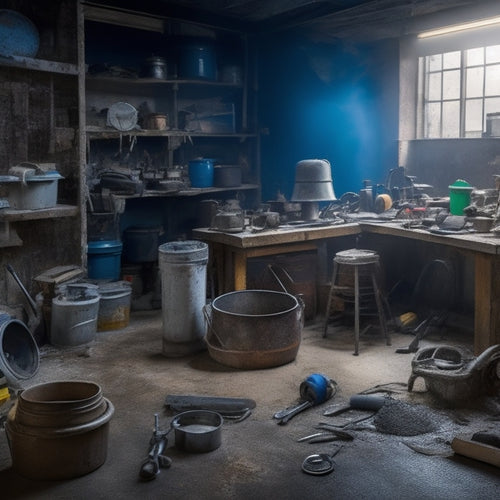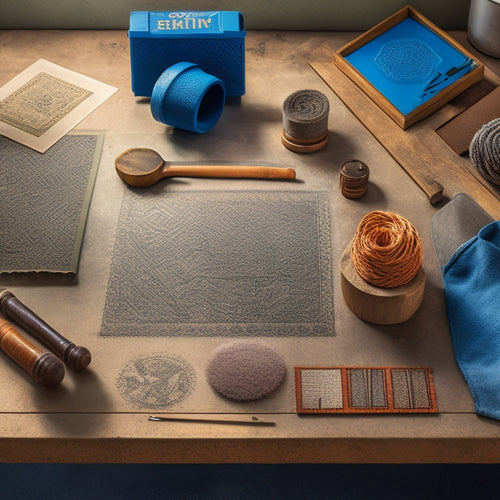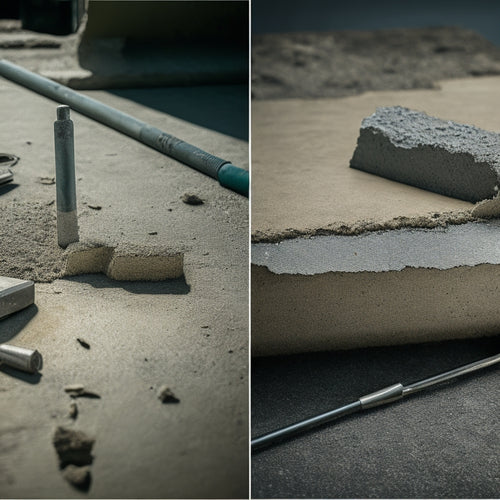
What Are the Best Tools for Stamped Concrete
Share
When it comes to achieving professional-looking stamped concrete, you'll need a range of specialized tools. Essential tools include surface preparation equipment like screed boards and tamping tools, as well as stamping mats and finishing tools that help replicate natural materials and patterns. You'll also need tools for creating clean edges, accessing hard-to-reach areas, and maintaining uniformity in your patterns. From texture mats to handle extensions, having the right tools is vital for a high-quality finish. By selecting the best tools for your project, you'll be well on your way to creating a stunning, realistic look that impresses - and there's more to explore to take your skills to the next level.
Key Takeaways
• Essential tools for stamped concrete include concrete surface preparation tools, screed boards, tamping tools, edgers, and stamping process tools.
• Texture mats, pattern stampers, and flex mats are necessary for achieving various patterns and designs in stamped concrete.
• A reliable tamping tool, handle extension/reach tool, and rubber mat/stamping pad are crucial for ensuring even pressure and preventing air pockets.
• Color charts and swatches, pattern and texture mats, and stamping tools and accessories are necessary for selecting and achieving cohesive designs.
• Regular tool maintenance, attention to detail, and a consistent stamping technique are critical for producing high-quality stamped concrete finishes.
Essential Tools for Stamping Concrete
When you're about to commence on a stamped concrete project, you'll need to assemble an arsenal of essential tools that will help you achieve the desired pattern, texture, and color.
These tools are vital for mastering various stamping techniques, which can make or break the final result.
To begin with, you'll need to prepare the concrete surface, ensuring it's level, clean, and free of any debris. This is where concrete preparation comes into play.
You'll need a range of tools to achieve the perfect surface, including a screed board, tamping tool, and edger.
Once the surface is ready, you can move on to the stamping process. This is where the magic happens, and the right tools can make all the difference.
You'll need stamping mats, texture mats, and release agents to achieve the desired pattern and texture.
Having the right tools at your disposal will enable you to experiment with different stamping techniques, resulting in a unique and professional-looking finish.
Best Tools for Stamped Concrete Patterns
You'll need a combination of mat styles and sizes to replicate the intricate patterns and textures found in natural materials, such as stone, wood, or brick, and achieve a realistic stamped concrete finish. This is where pattern stamping tools come into play. These tools are designed to create specific patterns and textures on your concrete surface.
Here are three essential pattern stamping tools to get you started:
-
Texture mats: These mats have a textured surface that mimics the natural material you're trying to replicate. They come in various patterns, such as stone, wood, and brick.
-
Pattern stampers: These tools have a specific design or pattern etched into them, which is then stamped onto the concrete surface. They're great for creating detailed, intricate designs.
-
Flex mats: These mats are flexible and can be bent to fit curved or irregular surfaces. They're perfect for creating stamped concrete patterns on stairs, curbs, or other non-linear surfaces.
Concrete Stamping Equipment Essentials
With your pattern stamping tools in hand, it's time to focus on the concrete stamping equipment that will help you achieve the perfect impression.
You'll need a reliable tamping tool to guarantee even pressure and prevent air pockets from forming. A high-quality tamper will also help you maintain a consistent stamping technique, which is vital for achieving a realistic pattern.
When it comes to stamping techniques, it's important to have a handle extension or reach tool to access hard-to-reach areas. This will allow you to stamp corners, edges, and other tight spaces with ease.
Additionally, a rubber mat or stamping pad can help you achieve a more defined pattern and prevent the stamp from slipping or sticking to the concrete.
Don't forget about maintenance tips for your equipment. Regularly clean and lubricate your tools to prevent rust and corrosion. Store them in a dry place to prevent damage from the elements.
Stamped Concrete Design Tools Needed
To achieve a realistic and visually appealing stamped concrete design, you need tools that can help you create precise patterns, textures, and colors. As a professional, you understand the importance of attention to detail in stamped concrete design techniques. The right tools can make all the difference in achieving a high-quality finish.
Here are some essential design tools you'll need:
-
Color charts and swatches: These help you select the perfect color combinations for your design, ensuring a cohesive look that complements the surrounding environment.
-
Pattern and texture mats: These mats feature various patterns and textures, allowing you to create realistic designs that mimic natural materials like stone, wood, or brick.
-
Stamping tools and accessories: These include tamping tools, texture skins, and other specialized tools that help you achieve precise patterns and textures.
Must-Have Tools for Concrete Stamping
Selecting the right tools for concrete stamping is essential to achieving a high-quality, long-lasting finish that meets your clients' expectations.
You'll need a combination of important tools to execute various stamping techniques and achieve the desired pattern, texture, and design. First, you'll need a set of stamping mats or texturing skins to create the desired pattern. Additionally, you'll require a tamper or tamping tool to guarantee proper stamp registration and to prevent air pockets. A fresno or bull float is necessary for smooth, even finishes, while an edger or jointer helps to create clean, defined edges.
Regular tool maintenance is also critical to extend the lifespan of your tools and guarantee consistent results. Clean and store your tools properly after each use, and perform routine checks for wear and tear. Regularly inspect your stamping mats for damage or deterioration, and replace them as needed.
Frequently Asked Questions
Can I Use Regular Concrete for Stamped Concrete Projects?
You can't use regular concrete for stamped concrete projects as it lacks the necessary workability and strength; stamped concrete techniques require specialized mixes that differ markedly from regular concrete regarding composition and performance.
How Long Does Stamped Concrete Last With Proper Maintenance?
As you commence on your stamped concrete journey, you'll be relieved to know that with proper maintenance, it can last up to 25 years or more, depending on factors like sealant quality, traffic, and climate, making it a durable, long-term investment.
Do I Need to Seal Stamped Concrete After It's Cured?
After the curing process, you'll need to seal your stamped concrete to protect it from the elements. Familiarize yourself with various sealing techniques to choose the best method for your project, ensuring a durable and long-lasting finish.
Can I Stamp Concrete in Cold or Hot Weather Conditions?
When you're planning to stamp concrete, consider the weather: extreme temperatures can affect the curing process. You'll need to adapt your stamping techniques to overcome weather challenges, whether it's cold or hot outside, to achieve the best results.
Is Stamped Concrete More Expensive Than Regular Concrete?
You're worried stamped concrete will break the bank, but surprisingly, it's only 10-20% more expensive than regular concrete, making it a worthwhile investment for its unique aesthetic and durability benefits, with pricing varying depending on design complexity and contractor expertise.
Conclusion
You've made it to the end of this exhaustive guide, and yet, you're still not a master stamper. That's because the best tools for stamped concrete are just the beginning.
It takes sweat, tears, and a whole lot of practice to achieve those jaw-dropping patterns. But don't worry, with these essentials by your side, you'll be well on your way to creating outdoor oases that'll make your neighbors weep with envy.
Just remember, it's not just about the tools – it's about the artistry that wields them.
Related Posts
-

7 Tools to Fix Damaged Concrete Floors
You're about to tackle that damaged concrete floor, and the right tools are essential for a successful repair. Start ...
-

5 Best Tools for Stamping Concrete Walls
When it comes to stamping concrete walls, you'll need a range of specialized tools to achieve the desired texture and...
-

Top Tools for Concrete Adhesion Success
When it comes to concrete adhesion success, you'll need to wield the right tools and techniques to guarantee a strong...


